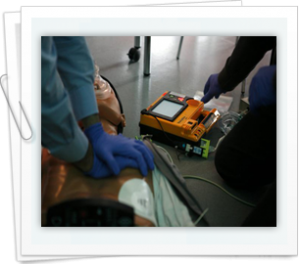Online CPR Certification Blog
Brain function best preserved with Compression-only CPR
Date: March 30th, 2014
 It was just a normal day when a simple method used to encourage bystanders and enlighten them on the use of CPR become more successful than earlier anticipated. This was largely attributed to the fact that the very same method taught could prove to be one of the best techniques of resuscitating a cardiac arrest victim or patient. The use of compression only or hand only should eradicate the need to utilize mouth to mouth. This will be highly ideal since a person can now shift their energy and focus on compressing the victim’s chest to save their life.
It was just a normal day when a simple method used to encourage bystanders and enlighten them on the use of CPR become more successful than earlier anticipated. This was largely attributed to the fact that the very same method taught could prove to be one of the best techniques of resuscitating a cardiac arrest victim or patient. The use of compression only or hand only should eradicate the need to utilize mouth to mouth. This will be highly ideal since a person can now shift their energy and focus on compressing the victim’s chest to save their life.
Where it all began
The promotion of hands on CPR began in the year 2008 with AHA (American Heart Association) in the forefront of the campaign. The used the beats of the then popular song ‘Staying Alive’ which was sang by the Bee Gee. The beats were to create a suitable pace to use when compressing the victim’s chest. According to experts, a lot of people were very afraid of performing the procedure since they thought they would do it wrong. A study has shown that victims who receive hands only CPR have a higher likelihood of surviving. It even gets better as the brain function of the victim is also likely to stay healthy. Chances of survival become even higher the faster the procedure is administered to the victim after an attack.
An in depth analysis of hands only CPR
According to a study done at Kyoto University School of Public health based in Japan, the use of hands only CPR keeps a higher number of people alive. The study further states that a huge number of the survivors if not all maintain normal brain functions. The researchers looked into the records of about 1376 people living in Japan, who suffered from cardiac arrest. This was between 2005 and 2009. Approximately, 36.8% received hands only CPR while 63.2 received traditional CPR (mouth to mouth). 46.4% of the hand only patients were still alive as compared to only 39.9% who received conventional CPR. In depth analysis of the study indicated that 40.7% of those who received compression only CPR maintained normal brain function as compared to 32.9% who got traditional CPR.
The leader of the study, Taku Iwami, said that there is a huge need to encourage people to perform CPR since a lot of the victims rarely get help from bystanders.
Portable devices that can be utilized to restore a heartbeat by sending shockwaves through the victim’s body are known as AED. It can be used in a public area.
Motivation for more people reacting to a cardiac arrest victim can come as a result in them having faith in the compression only procedure. They will trust their instincts since the probability of the procedure being a success is very high. The use of the beats from the song ‘Staying Alive’ can also help them keep up with the pace of compressions. This will be easier since they won’t have to remember or master the number of compressions per minute. They can just keep up with the song and they’ll be good to go.
